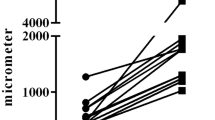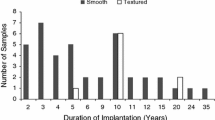Abstract
Background
In this study, breast implant capsular tissues and blood samples from 25 cases were studied to characterize the relationship between capsular findings and serum analysis. The serum fibrosis indexes hyaluronan and the aminoterminal propeptide of procollagen type III (PIIINP) are fairly well correlated in several other studies with the inflammation grade and fibrosis in patients with progressive fibrotic disorders such as liver cirrhosis.
Methods
The study enrolled 25 female patients (average age, 40 ± 12 years) with capsular contracture after bilateral cosmetic breast augmentation using smooth silicone gel implants (Mentor). The implants were placed in a submuscular position through an incision in the inframammary fold. The implant removals were prompted by development of capsular fibrosis (Baker grades 1–4). Samples of capsular tissue were obtained from all the patients for standard histologic and immunohistochemical analyses. Blood samples were drawn from all the patients immediately before surgery. Sera from 20 healthy female patients (average age, 34 ± 9 years) who had undergone plastic surgery for reduction mammaplasty were used as controls.
Results
Histology. Capsular tissue was significantly thicker in patients with grades 3 and 4 contracture than in women with grade 2 contracture according the classification by Baker. There was a moderate (n = 15) or severe (n = 10) chronic inflammatory reaction in the capsules around the implants. Fibroblasts and macrophages represented the major cell population found in the fibrous capsules. In addition, activated CD4+ cells were detected. An inner layer with synovia-like metaplasia and multinucleated giant cells was found. Fibroblast-like cells formed the most common cell type in the capsules, along with macrophages, scattered polymorphonuclear leukocytes, lymphocytes, plasma cells, and mast cells. Serum analysis. There was a significantly higher level (p < 0.05) of hyaluronan serum concentration in patients with capsular contracture (26 ± 14 μg/l) than in control subjects (12 ± 6 μg/l). There was a positive correlation between the grade of capsular contracture (Baker 1–4) and the hyaluronan serum concentration (Baker 1–2: 15 ± 3 μg/l; Baker 3–4: 35 ± 12 μg/l) (r2 =0.73; p < 0.05).
Conclusion
: In this study, serum hyaluronan levels were significantly elevated in patients with constrictive fibrosis after breast augmentation, and there was a positive correlation with the stage of capsular contracture. Serum hyaluronan concentration may help in defining patients at risk for capsular fibrosis. If treatment with new drugs can be started as a preventive measure, it may be possible to reduce the rate of patients who require surgical intervention.






Similar content being viewed by others
References
Alfano C, Mazzocchi M, Scuderi N: Mammary compliance: An objective measurement of capsular contracture. Aesth Plast Surg28:75–79, 2004
Baker JL Jr, Chandler ML, LeVier RR: Occurrence and activity of myofibroblasts in human capsular tissue surrounding mammary implants. Plast Reconstr Surg 68:905, 1981
Baran CN, Peker F, Ortak T, Sensoz O, Baran NK: A different strategy in the surgical treatment of capsular contracture: Leave capsule intact. Aesth Plast Surg 25:427–431, 2001
Beekman WH, Hage JJ, Jorna LB, Mulder JW: Augmentation mammaplasty: The story before the silicone bag prosthesis. Ann Plast Surg 43:446–451, 1999
Brody GS: On the safety of breast implants. Plast Reconstr Surg 100:1314–1321, 1997
Brown SL, Pennello G, Berg WA, Soo MS, Middleton MS: Silicone gel breast implant rupture, extracapsular silicone, and health status in a population of women. J Rheumatol 28:996–1003, 2001
Brunmark A, O’Rourke AM: Augmentation of mature CD44 cell response to isolated antigenic class II proteins by fibronectin and intercellular cell adhesion molecule-1. J Immunol 159:1676–1685, 1997
Burckhardt BR: Capsular contracture: Hard breasts, soft data. Clin Plast Surg 15:521, 1988
Camirand A, Doucet J: Breast augmentation: Teaching our patients how compression can help prevent capsular contracture. Aesth Plast Surg 24:221–226, 2000
Chiquet M: Regulation of extracellular matrix gene expression by mechanical stress. Matrix Biol 18:417–426, 1999
Cimons M: FDA plans safety reviews of several medical devices. Los Angeles Times, April 28, 1992, A-14
Cunningham B: Update on situation of breast implants in the U.S. Presented at EQUAM’s 3rd Consensus Conference, Regensburg, Germany, 1998
Deapen DM, Bestein L, Brody GS: Are breast implants anticarcinogenic? A 14-year–follow-up of the Los Angeles Study. Plast Reconst Surg 5:1346–1353, 1997
Dolores W, Rainer C, Niederegger H, Piza H, Wick G: Cellular and molecular composition of fibrous capsules formed around silicone breast implants with special focus on local immune reactions. J Autoimmunity 23:81–91, 2004
Embrey M, Adams EE, Cunningham B, Peters W, Young VL, Carlo GL: A review of the literature on the aetiology of capsular contracture and a pilot study to determine the outcome of capsular contracture interventions. Aesth Plast Surg 23:197–206, 1999
European Commission: Guidelines for conformity assessment of breast implants according to directive, 93/42/EEC relating to medical devices. European Commission. Directorate—General III Industry, Brussels, July 1998
Frangou J, Kanellaki M: The effect of local application of mitomycin-C on the development of capsule around silicone implants in the breast: An experimental study in mice. Aesth Plast Surg 25:118–128, 2001
Gabriel SE, et al.: Complications leading to surgery after breast implantation. N Engl J Med 336:677–682, 1997
Gerszten PC: A formal risk assessment of silicone breast implants. Biomaterial 20:1063–1069, 1999
Grigg M, Bondurand S, Ernster VL, Herdman R: Information for women about the safety of silicone breast implants. Report of the Institute of Medicine, Washington DC, June 1999
Gylbert L, Asplund O, Jurell G: Capsular contracture after breast reconstruction with silicone- and saline-filled implants: A 6-year follow-up. Plast Reconstr Surg 86:809–811, 1990
Heppleston AG, Styles JA, cited by Carr I: The macrophage. Academic Press: London, 1973,84
Karlson EW, Hankinson SE, Liang MH, Sanchez-Guerrero J, Colditz GA, Rosenau BJ, et al.: Association of silicone breast implants with immunologic abnormalities: A prospective study. Am J Med 106:11–19, 1999
Knudson W: The role of CD44 as a cell surface hyaluronan receptor during tumor invasion and metastasis. Frontiers Biosci 3:604–615, 1998
Kumari K, Weigel PH: Molecular cloning, expression, and characterization of the authentic hyaluronan synthase form group C Streptococcus equisimilis. J Biol Chem 272:32539–32546, 1997
Lossing C, Hansson H-A: Peptide growth factors and myofibroblasts in capsules around human breast implants. Plast Reconstr Surg 91:1277, 1993
Markovitz M, Cifonelli JA, Dorfman A: The biosynthesis of hyaluronic acid by group A streptococcus: VI. Biosynthesis from uridine nucleotides in cell-free extracts. J Biol Chem 234:2342–2350, 1959
Martin-Moreno J, Gorgojo L, Gonzales J, Wiesbaum W: Draft final report study: Health Risk Posed by Silicone Implants in General With a Special Attention to Breast Implants. European Commission Directorate General III Industry, Brussels, March 2000
Maxwell GP, Lugston PA: Management of complications following augmentation mammaplasty. In: Georgeade GS, Riefkohl R, Levin LS (eds) Georgeade plastic, maxillofacial and reconstructive surgery. 3rd ed. Williams & Wilkins: Baltimore, MD, 1997
Meyer K, Palmer JW: The polysaccharide of the vitreous humor. J Biol Chem 107:629–634, 1934
Neudecker BA, Stern R, Connolly MK: Aberrant serum hyaluronan and hyaluronidase levels in scleroderma. Br J Dermatol 150:469–476, 2004
Olivari N: Infection and capsular fibrosis. ISAPS 2004 postgraduate course, Berlin, March 2004
Perschl A, Lesley J, English N, Trowbridge I, Hyman R: Role of CD44 cytoplasmic domain in hyaluronan binding. Eur J Immunol 25:495–501, 1995
Peters WJ, Smith D, Lugowsky S: Failure properties of 352 explanted silicone implants: A report of 300 patients. Ann Plast Surg 34:3–6, 1995
Planas J, Cervelli V, Planas G: Five-year experience on ultrasonic treatment of breast contractures. Aesth Plast Surg 25:89–93, 2001
Puckett CL: On the safety of silicone gel implants. Cancer Invest 18:278–280, 2000
Rosenbaum D, Peric S, Holecek M, Ward HE: Hyaluronan in radiation-induced lung disease in the rat. Radiat Res 147:585, 1997
Schmits R, et al.: CD44 regulates hematopoietic progenitor distribution, granuloma formation, and tumorigenicity. Blood 90:2217–2223, 1997
Scott JE: Supramolecular organization of extracellular matrix glycosaminoglycans, in vitro and in the tissues. FASEB J 6:2639–2645, 1992
Sergott TJ, Limoli JP, Baldwin CM, Laub DR: human adjuvant disease, possible autoimmune disease after silicone implantation. Plast Reconstr Surg 78:104–111, 1986
Siggelkow W, Faridi A, Spiritus K, et al: Histological analysis of silicone breast implant capsules and correlation with capsular contracture. Biomaterials 24:1101, 2003
Sundstrom G, Lofvenberg E, Hassan I, Engstrom-Laurent A: Localisation and distribution of hyaluronan in normal bone marrow matrix: A novel method to evaluate impending fibrosis? Eur J Haematol 68:194, 2002
Takayanagi S, Nakagawa C, Sugimoto Y: Augmentation mammaplasty: Where should the implant be placed? Aesth Plast Surg 28:83–88, 2004
Tao J, Peng HQ, Cai WM, Dong FQ, Weng HL, Liu RH: Influence factors of serum fibrosis markers in liver fibrosis. World J Gastroenterol 9:2497–2500, 2003
Tenenbaum SA, Rice JC, Espinoza LR, Cuèllar ML, Plymale DR, Sander DM, et al.: Use of antipolymer antibody assay in recipients of silicone breast implants. Lancet 349:449–454, 1997
Tugwell P, Wells G, Peterson J, Welch V, Page J, Davison C, et al.: Do silicone breast implants cause rheumatologic disorders? A systemic review for a court-appointed national science panel. Arthritis Rheum 44:2477–2484, 2001
Tuhkanen A-L, Tammi M, Tammi R: CD44 substituted with heparan sulfate and endo-beta-galactosidase-sensitive oligosaccharides: A major proteoglycan in adult human epidermis. J Invest Dermatol 109:213–218, 1997
Ulrich D, Noah EM, Burchardt ER, Atkins D, Pallua N: Serum concentration of aminoterminal propeptide of type III procollagen (PIIINP) as a prognostic marker of skin fibrosis after scar correction in burned patients. Burns 28:766, 2002
Ulrich D, Noah EM, von Heimburg D, Pallua N: TIMP-1, MMP-2, -9, and PIIINP as serum markers for skin fibrosis in patients following severe burn trauma. Plast Reconstr Surg 111:1423, 2003
Vasquez B, Given KS, Housten GC: Breast augmentation: Review of subglandular and submascular implantation. Aesth Plast Surg 11:101–105, 1987
Weissmann B, Meyer K: The structure of hyalobiuronic acid and of hyaluronic acid from umbilical cord. J Am Chem Soc 76:1753–1757, 1954
Wells AF, Daniels S, Gunasekaran S, Wells KE: Local increase in hyaluronic acid and interleukin-2 in the capsules surrounding silicone breast implants. Ann Plast Surg 33:1–5, 1994
Wick G, Wagner R, Klima G, Wilfingseder P: Immunohistochemical analysis of the connective tissue capsule formation and constriction around mammary silicone prostheses. In: Kano K, Mori S, Sugisaki T, Torisu M (ed) Cellular, molecular, and genetic approaches to immunodiagnosis and immunotherapy. University of Tokyo Press. pp. 231–241, 1987
Wyatt HA, Dhawan A, Cheeseman P, Mieli-Vergani G, Price JF: Serum hyaluronic acid concentrations are increased in cystic fibrosis patients with liver disease. Arch Dis Child 86:190–193, 2002
Wyatt Lance E, Sinow J, Wollman JS, Sami DABS, Miller TA: The influence of time on human breast capsule histology: Smooth and textured silicone-surfaced implants. Plast Reconstr Surg 102:1922–1931, 1998
Xie SB, Yao JL, Zheng RQ, Peng XM, Gao ZL: Serum hyaluronic acid, procollagen type III and IV in histological diagnosis of liver fibrosis. Hepatobiliary Pancreat Dis Int 2:69–72, 2003
Author information
Authors and Affiliations
Corresponding author
Rights and permissions
About this article
Cite this article
Prantl, L., Pöppl, N., Horvat, N. et al. Serologic and Histologic Findings in Patients with Capsular Contracture After Breast Augmentation with Smooth Silicone Gel Implants: Is Serum Hyaluronan a Potential Predictor?. Aesth Plast Surg 29, 510–518 (2005). https://doi.org/10.1007/s00266-005-5049-y
Published:
Issue Date:
DOI: https://doi.org/10.1007/s00266-005-5049-y




